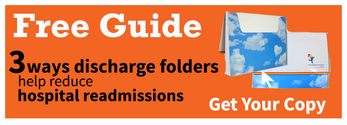One in five.
That's the number of elderly patients the federal government says will find themselves back in the hospital within 30 days of being discharged. While some re-admissions may be expected, due to continuation of treatment, the wide majority of incidences are unanticipated and many of those are preventable.
As surprising as a 20 percent re-admission rate might be, what's more surprising is that the solution for hospitals and healthcare networks might not lie in more state-of-the-art equipment, or more extensive and expensive medical tests, but something much simpler.
A Less Costly Solution
Instead, the solution for many healthcare providers may lie in something as ordinary and inexpensive as improved communication, and more specifically, the printed word.
Included in the Robert Wood Johnson Foundation's February 2013 report on the readmission crisis are results of 32 interviews with patients, caregivers and healthcare providers from the metropolitan Washington, D.C., New York City and Dallas areas.
Common Complaints
While no two stories were alike, there is a common theme running through most of the responses on re-admission causes. Consider these excerpts:
- "...he left the hospital dog tired...but no understanding of when to use his inhaler..."
- "...on her second trip to the hospital...she went home with instructions on how to better adjust her insulin..."
- "...there's not a lot of face time..."
While every patient's experience is unique, the report notes that by and large, patients with a new diagnosis reported not receiving or understanding information at discharge related to what they needed to know once back home. Patients also complained about rushed discharge processes that did not allow adequate time for questions or repetition of the most critical instructions.
Competing for Time
One of the things standing in the way of improved communication is what is often a rushed process for dismissal. A hospital discharge planner surveyed for the Foundation's report notes that patients discharged on a weekend are disadvantaged due to facilities being short on staff.
Even on a week day, staff may be interrupted numerous times while giving discharge instructions. Noises and other distractions may draw a patient's attention away from the instructions being provided. Written information provided in hard copy form often was difficult to understand or incomplete.
Printed and Organized
One obvious—and likely very effective—way to augment critical verbal instructions and provide greater depth of information is through the distribution of a professionally designed transition folder. A well designed transition or discharge folder includes all of the critical instructions a patient needs upon leaving the hospital and presents it in an organized easy to use manner.
By organizing critical documents such as prescription instructions, nutritional guidelines, and important hospital contact information in a transition folder as part of a discharge kit, patients and caregivers are able to refer back to the printed word rather than having to rely on their own notes or, worse yet, their memory.
The use of accordion folders or similarly designed discharge materials allow for a maximum number of documents to be provided in a way that puts critical information at the patients fingertips. In addition to general hospital information, transition folders can include such documents as key contact information, appointment schedules, disease-specific discharge instructions, lists of medications, medication explanations and similar useful pieces of literature.
Providing information in an easy-to-use transition folder ensures each patient has all the critical information they need to maintain their recovery in an organized easy to use package. Not only can a discharge folder reduce the opportunity for important instructions to be misplaced or accidentally discarded, it's also portable and easy to carry making it easy to bring to all follow up appointments where additional information can be added if necessary.
With the cost of re-admissions sky rocketing, the government keeping track of patient satisfaction scores, and assessing financial penalties for low scores, a transition folder that improves communication and potentially keeps patients from returning to the hospital can be worth it's weight in gold.

